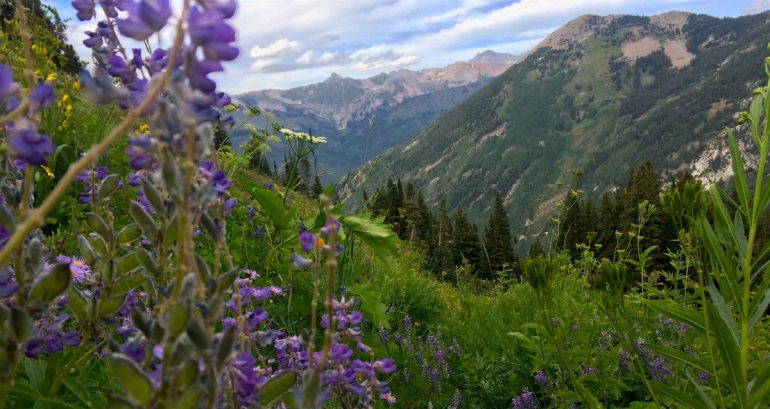In late summer, a favorite ski line takes on a new look
The mountain flowers are bursting. How can these mountainsides I last saw covered in deep snow now be blanketed in multi-colored carpets? I wonder this while striding slowly uphill, arms outstretched, fingertips brushing petals and stems as high as my hips.
Layers of violet lupines, crimson paintbrush and ivory daisies, golden ragwort, and brilliant shots of fireweed fill our neighborhood alpine bowl. They reach nearly all the way to the top of the it, the rounded summit where we’ve congregated so many times over so many winters to share high fives, don layers and pull skins before descending.
But it’s been several warm months since the last ski. Earlier in the afternoon, a friend and I start walking. The sky is clear, air cool, monsoon thunderheads absent. The apron of the mountain we ascend is quiet and calm. I hear branches squeak together and snap. My eyes dart, thinking it a bear. Treeline spits us into the edges of the bowl and the view opens. We walk steady up.
How strange to know a mountain in snow, I think, and not at all in sun-fed flowers. To hike a well-beaten path to its top, rather than breaking a fresh skin track. To traverse a new area of the mountain because that is where the trail leads, instead of following the safest path of least resistance across and up its otherwise untracked terrain.
From the summit we absorb a view last seen cloaked in winter. The familiar shapes of neighboring peaks are bare now, their tops, ridgelines and bowls dry. Rock creases and ribs that are so striking when contrasted by downy white are made plain and almost nondescript in its absence. Beautiful still, but a different kind of beauty.
From our lofty vantage we gaze over surrounding valleys laid with dense foliage. The trees are like broccoli tops, my friend says. Indeed, the clumps of aspens reach so high with long skinny trunks and canopies full spheres of trembling heart-shaped leaves. Before long the leaves will gold and brown and then drop and be buried until late spring. Forever from now, though, it seems.
On the slow walk down, our quads burn, knees jerk, sneakers slip on little pebbles. Surely this is harder than skiing, I think. But it’s like we’re skiing, my friend says.
It’s just much, much slower and with fewer arcs, and no yips and hollers of jubilance. The whisper of metal edges breaking snow crystals is replaced by the whoosh of birds flushing from flower stalks. They dart in and out in the fading light; one swoops so close to my nose I feel the breeze from its wings.
The trail descends into dense spruce. On a series of switchbacks I gaze down the thickly treed slope beside me and think: wow that’s steep. And thick. Did we ski that? Would I ski that?
We must’ve, but I can’t remember.
Landscapes shift when free of snow. Features morph — become larger and smaller, more or less ominous. A ravine we call a death trap is flooded with delicate purple petals. The slope angles so thrilling to carve gracefully are thigh bruising and painstaking to step down. Avalanche paths harbor brilliant wildflower kaleidoscopes. The tangled deadfall of the forest is menacing, traps waiting for ambitious early season ski tips to slip between snow-disguised trunks and branches strewn across the needle-padded floors.
But it is easier to spend longer admiring the mountains in sun. Long summer days bleed into long summer evenings where sunset sits suspended on the bare mountaintops, making them glow seemingly for hours. The green that temporarily blankets snow fed bowls and cirques takes a gold tint, like treasure.
We reach the dirt road at true dusk, our valley now deep in shadow and the peaks around us turning soft grey. Goosebumps rise on my bare legs. I hug my arms across my chest. My friend zips her jacket. The warmth of the day is now as fleeting as the cold of night that follows, the hint of another season ripening and nearing its turn.
It gives a new view, at least, for a moment.
Like what you’re reading? See more stories, and sign up for our weekly newsletter.
[mc4wp_form id=”26300″]
Manasseh Franklin is a writer, editor and big fan of walking uphill. She has an MFA in creative nonfiction and environment and natural resources from the University of Wyoming and especially enjoys writing about glaciers. Find her other work in Alpinist, Adventure Journal, Rock and Ice, Aspen Sojourner, AFAR, Trail Runner and Western Confluence.

